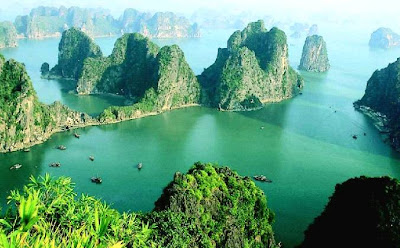Ha Long Bay is in the Gulf of Tonkin and
includes some 1,600 islands and islets, making spectacular seascape of
limestone pillars. Because of their abrupt nature, most of the islands
are uninhabited and unaffected by human presence. The great biological
interest is situated in the Gulf of Tonkin.
The smaller islands
are fenglin towers of 50m to 100m high. Many have vertical walls on all
or most sides and these continue to evolve by rock falls and large slab
failures. A distinctive feature of Ha Long Bay is the abundance of
lakes within the larger limestone islands.
"Ha Long" means "Bay of Descending Dragons" (Chinese: 下龙湾; Xiàlóngwān),
though prior to the 19th century this name was not recorded in any
document or archive. When mentioning the present-day Quang Ninh Sea or
Ha Long Bay, old historical books often referred to them by the names of
An Bang, Luc Thuy or Van Don. Not until the late 19th century did the name of Ha Long Bay appear on a French Marine Map. The Hai Phong News, a French newspaper of the time, had an article, Dragon appears on Ha Long Bay, reporting the following story: In 1898 a sub-lieutenant named Lagredin, captaining the Avalanse
reported seeing a huge sea snake on Ha Long Bay. This was also
witnessed by many of the crews. Thus emerged the European image of the
Asian dragon. Whether this appearance of a strange animal looking like a
dragon resulted the name of Ha Long Bay is not known.
The Ha Long Bay archipelago is made up of 1969 islands, both
settled and uninhabited. These can be accessed from various ports,
though in the special case of Cat Ba you can also arrive either by car, motorbike or bus (via Haiphong) or combined bus/boat (from Hanoi via Halong City).
Get in
There are a huge number of domestic connections, particularly to the ports of Halong City and Haiphong.
From Nanning in China's Guangxi province, the Nanning International Tourist Distribution Center (有爱南路10号(中华路口); Yǒuàinánlù shí hào (zhōnghuá lùkǒu); #10 You'ai Nanlu on the corner of Zhonghua Lu) provides daily buses to Halong City (170元, 8 hours) at 7:30AM.
By tour
There are many package tours from Hanoi,
but these are best avoided and characterized by long and crowded bus
rides, tourist-oriented rip-off trips on boats so slow you could swim
faster (to get you to buy more food and drink on board), and other shady
practices.
Get around
The islands can be accessed from various ports.
Ports
- Haiphong, a large historic port city at the mouth of the Red River that and the fourth largest city in Vietnam
- Halong City, spanning a portion of the northern part of the archipelago. Note that there are multiple ports within this town, in that at least one port exists that is wholly distinct from that of the tourist boat piers.
- Cai Rong, a small port serving the north-easterly part of the archipelago.
Airports
Helicopter trips can be taken from Gia Lam Airport in Hanoi.
Islands
- Ban Sen, a thickly forested, almost uninhabited island reachable by ferries to Quan Lan from Cai Rong.
- Cat Ba, the home of the endangered Cat Ba langur, a national park, numerous caves and the most popular destination in Ha Long Bay for tourists. It can either accessed by local bus and ferry from Hanoi's Lương Yên bus station (recommended), by tourist boat from Halong City (a five hour 'hard sell' ordeal; this is what the hordes of Hanoi package tourists do), or by local bus or ferry from Haiphong (less scenic).
- Quan Lạn, a historically significant outlying island with the beginnings of some tourism infrastructure and some beautiful beaches. Reachable by ferry from Cai Rong or also (reportedly) from Halong City.
- Van Don, a large island that is well inhabited, little visited by tourists and connected by road to the mainland near Cửa Ông.





